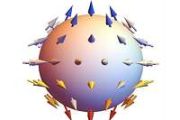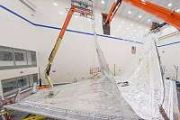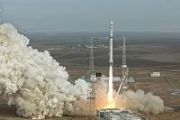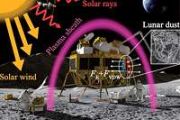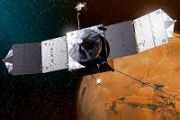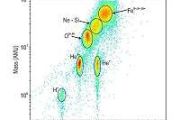
Copernical Team
Progress of Radiation Belt Exploration Enhanced by Small Satellite Constellation Mission CORBES
 In line with the COSPAR Scientific Roadmap on Small Satellites for Space Science, the CORBES mission, proposed by the Small Geostationary Radiation Belt (SGRB) division of TGCSS, is advancing Earth's radiation belt research through a constellation of multi-CubeSats. This constellation has been under development for two years and aims to conduct a fast-paced survey of Earth's radiation belts.
In line with the COSPAR Scientific Roadmap on Small Satellites for Space Science, the CORBES mission, proposed by the Small Geostationary Radiation Belt (SGRB) division of TGCSS, is advancing Earth's radiation belt research through a constellation of multi-CubeSats. This constellation has been under development for two years and aims to conduct a fast-paced survey of Earth's radiation belts. Highest-energy gamma rays detected at Milky Way's core
 At the High-Altitude Water Cherenkov (HAWC) observatory, positioned 13,000 feet above sea level on Mexico's Sierra Negra volcano, scientists have uncovered unprecedented levels of gamma-ray energy from the center of the Milky Way. This groundbreaking observation, led by an international team including researchers from Los Alamos National Laboratory, has recorded gamma rays exceeding 100 teraelec
At the High-Altitude Water Cherenkov (HAWC) observatory, positioned 13,000 feet above sea level on Mexico's Sierra Negra volcano, scientists have uncovered unprecedented levels of gamma-ray energy from the center of the Milky Way. This groundbreaking observation, led by an international team including researchers from Los Alamos National Laboratory, has recorded gamma rays exceeding 100 teraelec Saturn's moon Titan may have thick insulating methane ice crust up to six miles
 Saturn's largest moon, Titan, stands out as the only celestial body besides Earth with a dense atmosphere and surface liquids, such as rivers, lakes, and seas. Due to its frigid environment, these liquids comprise hydrocarbons like methane and ethane, while Titan's surface primarily consists of solid water ice. Recent findings led by planetary scientists at the University of Hawai'i at Manoa sug
Saturn's largest moon, Titan, stands out as the only celestial body besides Earth with a dense atmosphere and surface liquids, such as rivers, lakes, and seas. Due to its frigid environment, these liquids comprise hydrocarbons like methane and ethane, while Titan's surface primarily consists of solid water ice. Recent findings led by planetary scientists at the University of Hawai'i at Manoa sug Red Rocks with Green Spots at 'Serpentine Rapids'
 After discovering and sampling the "leopard spots" of "Bright Angel," it became apparent that Perseverance's journey of discovery in this region was not yet finished. Approximately 20 sols (Martian days) after driving south across Neretva Vallis from Bright Angel, the rover discovered the enigmatic and unique red rocks of "Serpentine Rapids."
At Serpentine Rapids, Perseverance used its abr
After discovering and sampling the "leopard spots" of "Bright Angel," it became apparent that Perseverance's journey of discovery in this region was not yet finished. Approximately 20 sols (Martian days) after driving south across Neretva Vallis from Bright Angel, the rover discovered the enigmatic and unique red rocks of "Serpentine Rapids."
At Serpentine Rapids, Perseverance used its abr SpaceX sends 22 Starlink satellites into orbit in record-setting launch
 SpaceX on Saturday successfully launched a Falcon 9 rocket carrying a payload of 22 Starlink Internet communications satellite from Cape Canaveral in Florida, marking a state record 73rd orbital rocket launch this year.
The Falcon 9 rose from Launch Complex 40 at the Kennedy Space Center as scheduled at 5:47 p.m. EDT.
Less than 10 minutes later, the first-stage booster used in 18
SpaceX on Saturday successfully launched a Falcon 9 rocket carrying a payload of 22 Starlink Internet communications satellite from Cape Canaveral in Florida, marking a state record 73rd orbital rocket launch this year.
The Falcon 9 rose from Launch Complex 40 at the Kennedy Space Center as scheduled at 5:47 p.m. EDT.
Less than 10 minutes later, the first-stage booster used in 18 Kremlin denies report of Musk-Putin secret talks
 The Kremlin on Friday denied a report by The Wall Street Journal that Russian President Vladimir Putin and billionaire SpaceX founder Elon Musk had been in regular secret contact since 2022.
"It's all untrue, absolutely false information published in the newspaper," Kremlin spokesman Dmitry Peskov told journalists.
The WSJ report claimed Putin had discussed personal and political matter
The Kremlin on Friday denied a report by The Wall Street Journal that Russian President Vladimir Putin and billionaire SpaceX founder Elon Musk had been in regular secret contact since 2022.
"It's all untrue, absolutely false information published in the newspaper," Kremlin spokesman Dmitry Peskov told journalists.
The WSJ report claimed Putin had discussed personal and political matter Astronauts Safely Return to Earth After Seven Months of Research on ISS
 After spending seven months on the International Space Station (ISS), astronauts from NASA's eighth SpaceX crew rotation (Crew-8) successfully splashed down off Florida's coast. This mission, part of NASA's Commercial Crew Program, included NASA astronauts Matthew Dominick, Michael Barratt, and Jeanette Epps, alongside Roscosmos cosmonaut Alexander Grebenkin. The NASA crew conducted extensive re
After spending seven months on the International Space Station (ISS), astronauts from NASA's eighth SpaceX crew rotation (Crew-8) successfully splashed down off Florida's coast. This mission, part of NASA's Commercial Crew Program, included NASA astronauts Matthew Dominick, Michael Barratt, and Jeanette Epps, alongside Roscosmos cosmonaut Alexander Grebenkin. The NASA crew conducted extensive re Astronomers Identify New Organic Molecule in Interstellar Space
 The element carbon, foundational to life on Earth and potentially elsewhere, is known to exist in vast quantities across space. However, locating substantial amounts of carbon in interstellar regions has proven unexpectedly challenging.
A recent discovery, involving the detection of a complex molecule known as 1-cyanopyrene, offers new insight into how carbon-rich compounds form and persis
The element carbon, foundational to life on Earth and potentially elsewhere, is known to exist in vast quantities across space. However, locating substantial amounts of carbon in interstellar regions has proven unexpectedly challenging.
A recent discovery, involving the detection of a complex molecule known as 1-cyanopyrene, offers new insight into how carbon-rich compounds form and persis Latest Findings from China's Lunar and Mars Exploration Missions 2022-2024
 China's recent lunar and Mars missions have provided unprecedented insights into the geological and environmental conditions of the Moon and Mars, yielding crucial data for future exploration.
b>Chang'e-4 Lunar Mission: Far Side Insights br> /b>
China's Chang'e-4 mission achieved the first successful landing on the Moon's far side, specifically within the Von Karman crater in the South
China's recent lunar and Mars missions have provided unprecedented insights into the geological and environmental conditions of the Moon and Mars, yielding crucial data for future exploration.
b>Chang'e-4 Lunar Mission: Far Side Insights br> /b>
China's Chang'e-4 mission achieved the first successful landing on the Moon's far side, specifically within the Von Karman crater in the South NASA Administrator Nelson says report of Musk contacts with Putin 'concerning'
 NASA Administrator Bill Nelson says reported secret conversations held between SpaceX CEO Elon Musk and Russian President Vladimir Putin are "concerning" and, if true, should be investigated.
Speaking Friday an event hosted by the online news site Semafor, Nelson was asked about this week's story in the Wall Street Journal, which reported that Musk and Putin have been holding secret con
NASA Administrator Bill Nelson says reported secret conversations held between SpaceX CEO Elon Musk and Russian President Vladimir Putin are "concerning" and, if true, should be investigated.
Speaking Friday an event hosted by the online news site Semafor, Nelson was asked about this week's story in the Wall Street Journal, which reported that Musk and Putin have been holding secret con 



